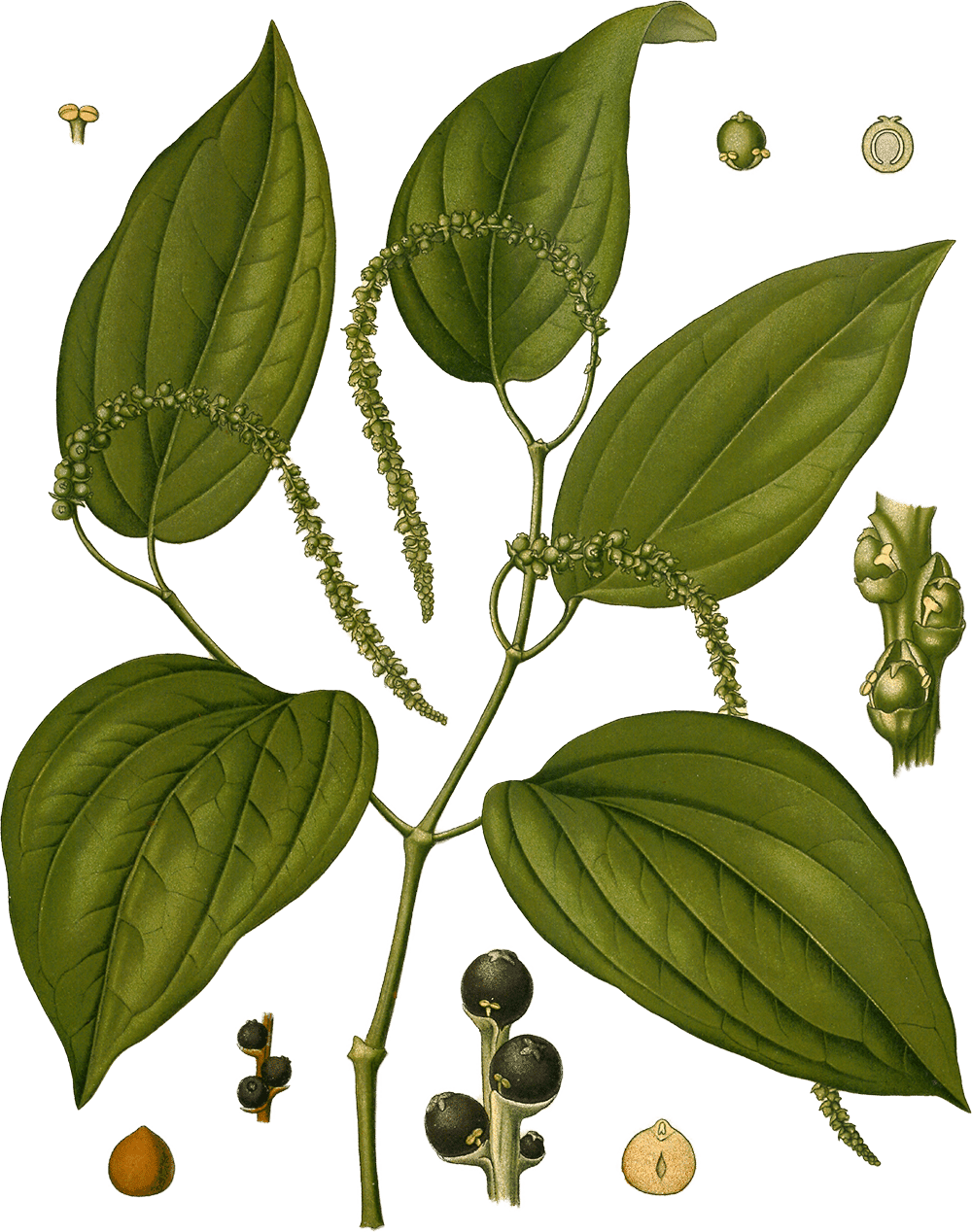Pepper #

Illustration of Piper nigrum L. from Köhler's Medizinal-Pflanzen (1887)
Pepper (Piper nigrum L.) is a culinary and medicinal spice from the Piperaceae family,1 originating in the region(s) of Malabar coast (South India).2 It is used for its fruit, primarily for flavors; colds. Its aroma is described as pungent, hot, with a heat index of 3-8.3
| English | Arabic | Chinese | Hungarian |
|---|---|---|---|
| pepper | فلفل | 胡椒 | bors |
Overview #
| id | pepper |
|---|---|
| species name | Piper nigrum L. |
| family | Piperaceae |
| part used | fruit |
| macroarea | Asia |
| region of origin | Malabar coast (South India) |
| cultivation | Vietnam; Brazil; Indonesia; India; Sri Lanka; etc. |
| color | black; white; green |
| botanical database | POWO |
Etymologies #
English pepper < West Germanic * pipor ‘id.’ < Latin piper ‘black pepper, long pepper’ < Ancient Greek πέπερι péperi ‘id.’ < Middle Indo-Aryan पिप्परी pipparī ’long pepper’ < Sanskrit पिप्पलि pippali ’long pepper Piper longum (plant and berry); a berry’
Arabic فلفل filfil, fulful ‘pepper’ < Persian پلپل pilpil ‘id.’; cf. cognates Old Armenian płpeł, Old Georgian ṗilṗili < Middle Indo-Aryan ? ’long pepper’ < Sanskrit पिप्पलि pippali ’long pepper Piper longum (plant and berry); a berry’
Mandarin Chinese 胡椒 hújiāo ‘black pepper’ [barbarian-pepper ], from 胡 hú ‘Western barbarians, steppe nomads’ + 椒 jiāo ‘pepper, spice’ (jiāo was the prototype spice in China, originally referring to the local “Sichuan pepper” which is now called 花椒 huājiāo [flower-pepper ]), [Northern and Southern ] 420-445
Names #
English #
| term | source |
|---|---|
| pepper | OED |
| black pepper | OED |
| white pepper | OED |
| green pepper | OED |
| peppercorn | OED |
Arabic #
| script | term | literal | source |
|---|---|---|---|
| فلفل | fulful | Wehr, 1976 | |
| فلفل أبيض | fulful abyaḍ | white pepper | Baalbaki, 1995 |
| فلفل أسود | fulful aswad | black pepper | Baalbaki, 1995 |
| فلفلة | fulfula | Wehr, 1976 |
Chinese #
| script | term | literal | source |
|---|---|---|---|
| 胡椒 | hújiāo | barbarian-pepper | Defrancis, 2003 |
| 白胡椒 | báihújiāo | white-barbarian-pepper | MDBG |
| 黑胡椒 | hēihújiāo | black-barbarian-pepper | MDBG |
| 綠胡椒 | lǜhújiāo | green-barbarian-pepper | Regency Spices, 2022 |
| 青胡椒 | qīnghújiāo | green-barbarian-pepper | Regency Spices, 2022 |
POWO. (2022). Plants of the World Online (Botanical Database). Facilitated by the Royal Botanic Gardens, Kew. http://www.plantsoftheworldonline.org/ ↩︎
van Wyk, B.-E. (2014). Culinary Herbs and Spices of the World. University of Chicago Press, joint publication with the Royal Botanic Gardens, Kew. https://doi.org/10.7208/chicago/9780226091839.001.0001 ↩︎
Medicinal Spices Exhibit. (2002). UCLA Biomedical Library: History & Special Collections. https://unitproj.library.ucla.edu/biomed/spice/index.cfm?spicefilename=taste.txt&itemsuppress=yes&displayswitch=0 ↩︎